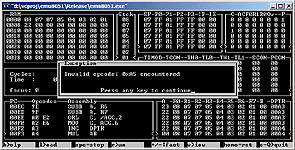8051 Emulator
Releases
v0.72 win32 binary
(console app)
v0.72 OSX Intel binary
(console app) (compiled by third party, unsupported)
v0.72 sources
(c and c++)
documentation
You may also wish to check out Atanua, real time logic simulator, which also includes 8051 chip.
Earlier releases
v0.71 win32 binary
(console app w/docs)
v0.71 sources
(c and c++)
v0.7 win32 binary
(console app w/docs)
v0.7 sources
(c and c++)
Preview versions
v0.6 win32 binary
(console app w/docs)
v0.4 win32 binary
(console app)
v0.3 win32 binary
(console app) (updated: does not need ttcore.dll anymore)
v0.2 win32 binary
(console app)
v0.1 win32 binary
(console app)


8051 emulator v.0.1, console app
This is a simulator of the 8051/8052 microcontrollers. For sake of simplicity, I'm only referring to 8051, although the emulator can emulate either one. For more information about the 8-bit chip(s), please check out www.8052.com or look up the data sheets. Intel, being the originator of the architecture, naturally has information as well.
The 8051 is a pretty easy chip to play with, in both hardware and software. Hence, it's a good chip to use as an example when teaching about computer hardware. Unfortunately, the simulators in use in my school were a bit outdated, so I decided to write a new one.
The scope of the emulator is to help test and debug 8051 assembler programs. What is particularily left out is clock-cycle exact simulation of processor pins. (For instance, MUL is a 48-clock operation on the 8051. On which clock cycle does the CPU read the operands? Or write the result?). Such simulation might help in designing some hardware, but for most uses it is unneccessary and complicated.
The emulator is designed to have two separate modules, consisting of the emulator core and separate front-end. This enables the creation of different kinds of front-ends. For instance, this lets the user use the emulator core as a DLL in a C/C++ application which can simulate other kinds of hardware (such as leds, switches, displays, audio, or whatnot).
Simulation accuracy is valued over speed. Nevertheless, already at v.0.1 the emulator could run at over-realtime speeds on a P4/2.6GHz (running the emulator at over 12MHz). Based on profiler output, over half of the processing time is wasted on pipeline trashing when branching to the opcode functions. This could possibly be helped by JITing the code, but that is considered unneccessary at this point. Also, CPUs with shorter pipelines are not harmed by this behavior as badly.
The emulator is written completely in ANSI C for portability, and the sources are available under the MIT license.
Current features include:
- Full 8051 instruction set.
- ncurses-based UI - works fine over SSH for instance.
The main view includes:
- Memory view.
- Stack view.
- Opcode and disassembly view.
- History view of SP, P0, P1, P2, P3, IP, IE, TMOD, TCON, TH0, TL0, TH1, TL1, SCON, PCON, A, B, R0, R1, R2, R3, R4, R5, R6, R7 and DPTR, as well as all processor status bits.
- Cycle and real-time counter.
Other views include:
-
Logic board (leds'n'switches) view, with optional widgets such as 7-seg displays and 44780-style text output
-
Memory editor, showing all five types of memory at the same time
-
Options, where user can disable debug exceptions etc.
-
Support for all sorts of 8051 memory combinations - 128 or 256B internal RAM, 0-64k of external RAM and 0-64k of ROM. External RAM and ROM may even point at the same memory, enabling self-modifying code.
-
Loads Intel HEX files.
-
Support for exceptions on invalid instructions, odd stack behavior, and messing up important registers in interrupts. One breakpoint is also supported.
-
The emulator performs callbacks on register area or external memory read/write, which can be used to implement simulation of new special features or whatever is connected to the IO ports.
-
Timer 0 and 1 modes 0, 1, 2 and 3, as well as interrupt priorities.